
From Johann Martin Bernigeroth “Les Costumes des Francs-Macons dans leurs Assemblees,” ca. 1745. (By permission of the Board of General Purposes of the United Grand Lodge of England.) This rare French print depicts the Masonic third-degree ritual: the raising of the master Mason. Although the “teardrop” symbol is associated specifically with French Masonry, other elements are characteristic of the British ritual.

Masonic master’s chair by Benjamin Bucktrout, Williamsburg, Virginia, 1769–1775. Mahogany with walnut; painted and gilded ornament, original leather upholstery. H. 65 1/2", W. 31 1/4", D. 29 1/2". (Courtesy, Colonial Williamsburg Foundation; photo, Hans Lorenz.)
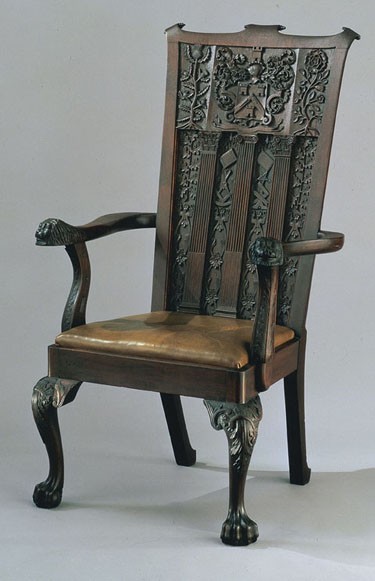
Masonic master’s chair, Williamsburg Lodge No. 6, Williamsburg, Virginia, 1765–1770. Mahogany. H. 52 1/4", W. 29 1/2", D. 26 1/4". (Courtesy, Williamsburg Lodge No. 6, A.F. & A.M.; photo, Hans Lorenz.)

Masonic master’s chair, Fredericksburg Lodge No. 4, Fredericksburg, Virginia, ca. 1775. Mahogany with walnut. H. 42 1/2", W. 27 1/2", D. 18 7/8". (Courtesy, Fredericksburg Lodge No. 4, A.F. & A.M; photo, Museum of Early Southern Decorative Arts.) The Fredericksburg Lodge was chartered by the Grand Lodge of Scotland in 1758. The symbol of the sundial on this chair associates it with Scottish Freemasonry.

Masonic chair, Union Kilwinning Lodge No. 4, Charleston, South Carolina, ca. 1770. Mahogany; ash slip seat. H. 53 1/2", W. 27 1/2". (Collection of the Museum of Early Southern Decorative Arts.) The painted square and compass cover an original inlaid plumb rule, indicating that this chair served the senior warden of the lodge.
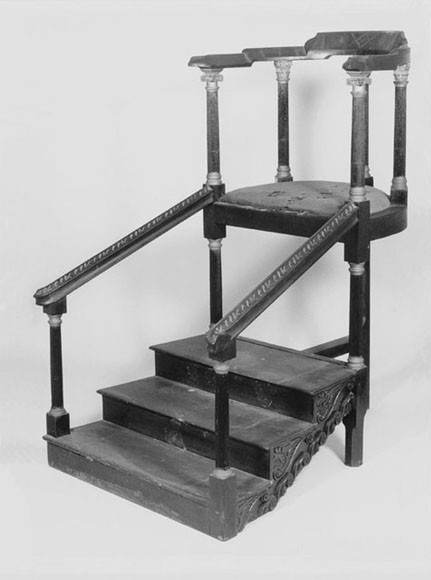
Masonic master’s chair attributed to Richard Hall, Royal White Hart Lodge No. 2, Halifax, North Carolina, ca. 1765. Walnut; yellow pine slip seat. H. 48 9/16", W. 24", D. 17" (seat). (Courtesy, Royal White Hart Lodge No. 2, A.F. & A.M.; photo, Museum of Early Southern Decorative Arts.)
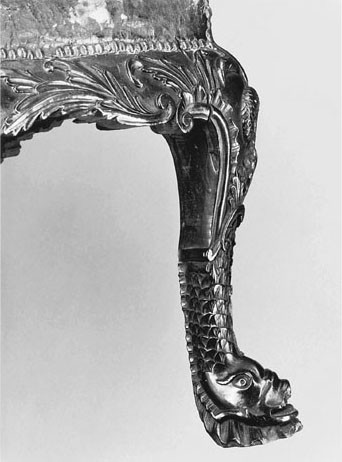
Detail of the carved dolphin leg on the chair illustrated in fig. 2. (Photo, Hans Lorenz.)
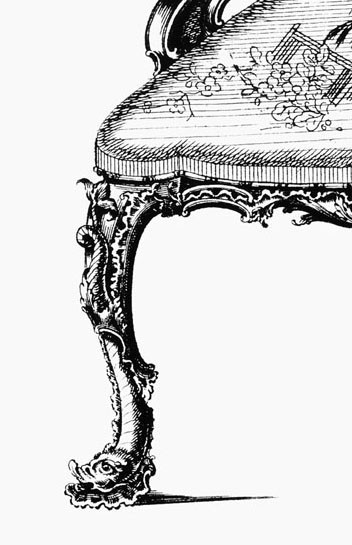
Detail of plate 21 in Thomas Chippendale’s The Gentleman and Cabinet-Maker’s Director, 1st ed. (London, 1754). (Courtesy, Colonial Williamsburg Foundation.)
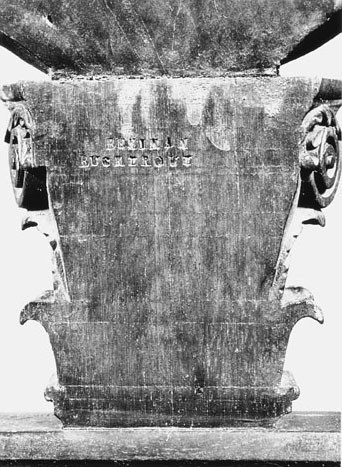
Detail of the stamped signature and layout lines for the carving on the back of the Composite capital on the chair illustrated in fig. 2. (Photo, F. C. Howlett.)

“Composite Order” from Thomas Chippendale’s The Gentleman and Cabinet-Maker’s Director, 1st ed. (London, 1754). (Courtsey, Colonial Williamsburg Foundation.)
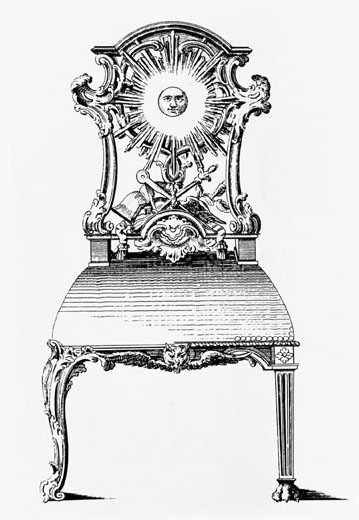
Masonic chair illustrated on plate 25 of Thomas Chippendale’s The Gentleman and Cabinet-Maker’s Director, 3d ed. (London, 1762).
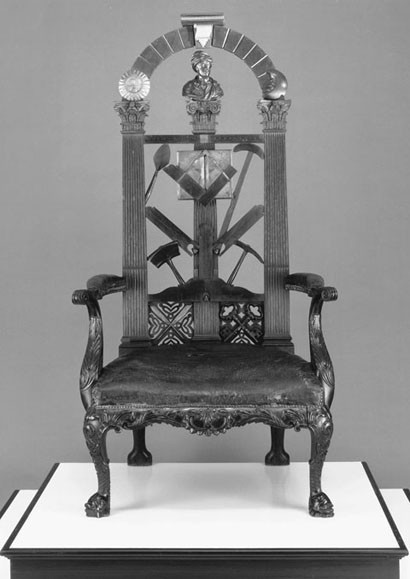
Preconservation view of the chair illustrated in fig. 2, showing many of the symbolic elements missing or obscured by darkened varnish and overpaint. (Photo, Hans Lorenz.)

Frontis of James Hasolle, esq., Chymical Collections (London, 1650). (By permission of the Board of General Purposes of the United Grand Lodge of England.) The frontis of this seventeenth-century alchemical text has symbols later incorporated into speculative Masonry.
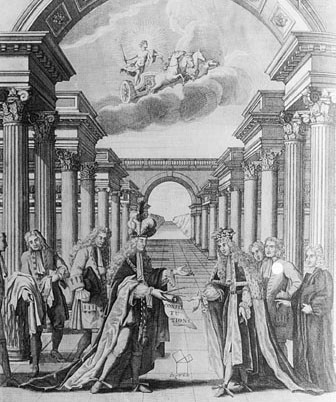
Frontis of James Anderson’s The Constitutions of the Freemasons (London: William Hunter and John Hooke, 1723). (By permission of the Board of General Purposes of the United Grand Lodge of England.) This was the first publication authorized by the newly formed (1717) Grand Lodge of England.
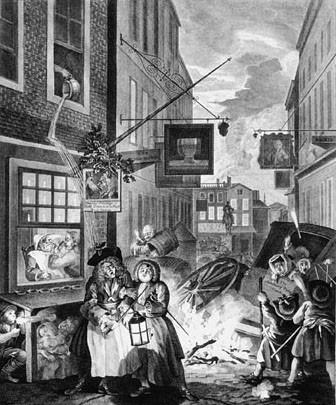
William Hogarth, Night, from the Times of Day series, London, 1738. (Courtesy, Colonial Williamsburg Foundation.) Hogarth was a Freemason who nonetheless parodied the association of the Craft with late-night drunkenness.
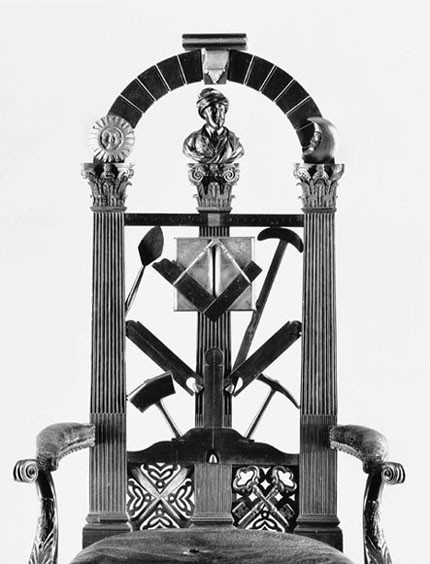
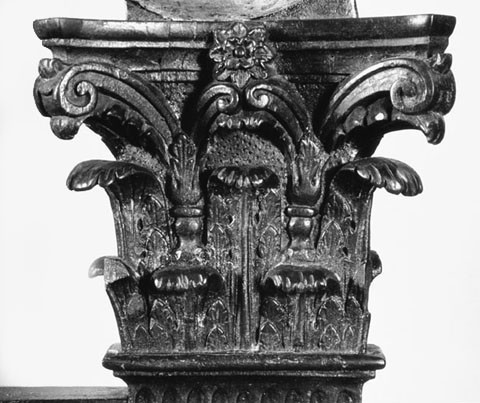
Preconservation detail of the right capital of the chair illustrated in fig. 2, showing numerous losses and a poor repair mimicking the form of the missing upper portion. (Photo, F. C. Howlett.)
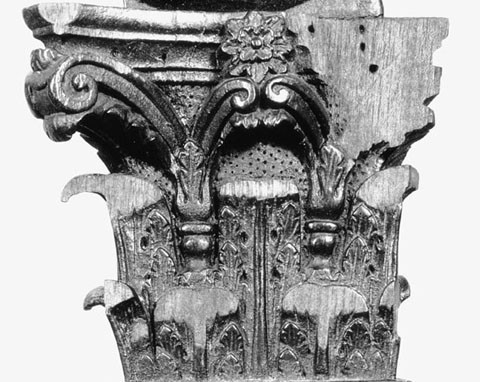
Detail of the right capital of the chair illustrated in fig. 2 during treatment, which included removal of old repairs, glue, and varnish from areas of loss prior to attaching replacements. (Photo, F. C. Howlett.)
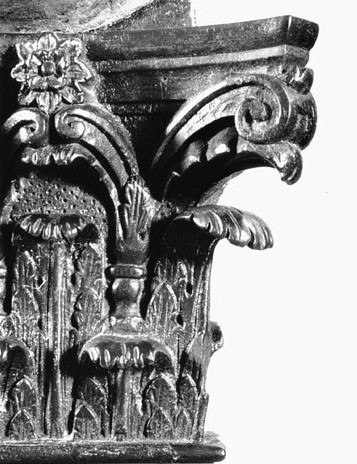
Post-conservation detail of the right capital of the chair illustrated in fig. 2 with replacements carved and toned to match the adjacent surfaces. (Photo, Hans Lorenz.)
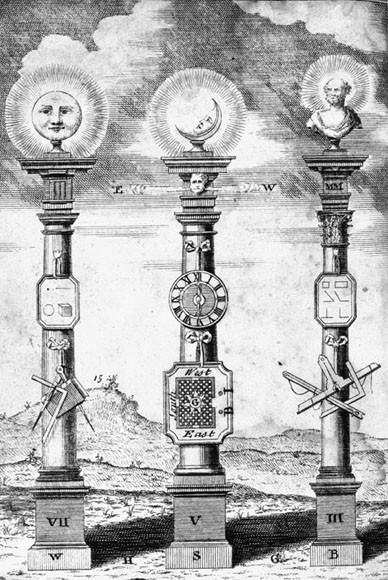
Frontis of Thomas and Batty Langley’s The Builder’s Jewel: or the Youth’s Instructor, and Workman’s Remembrancer (1741; reprint ed., London: R. Ware, 1754). (Courtesy, Colonial Williamsburg Foundation.)
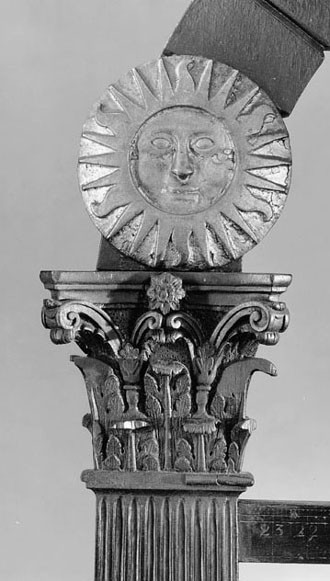
Preconservation detail of the sun on the chair illustrated in fig. 2, showing degraded bronze paint obscuring earlier layers of gold leaf. (Photo, Hans Lorenz.)
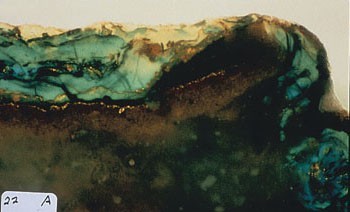
Cross-section of a sample taken from the sun (200x), viewed with a combination of visible light and near-ultraviolet light to reveal original gilding and restoration layers. (Photo, F. C. Howlett.)
22.1 Bronze paint (bronze powder in plant resin)
22.2 Bronze paint (bronze powder in plant resin)
22.3 Gold leaf
22.4 Oil size
22.5 Original gold leaf
22.6 Red bole
22.7 Gesso
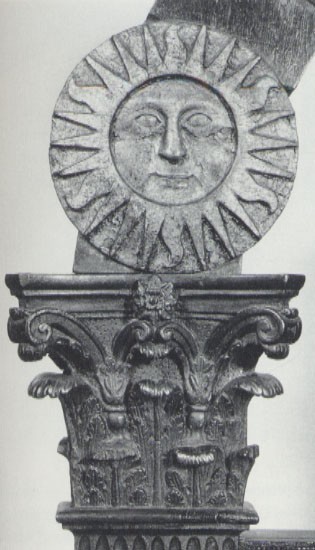
Post-conservation detail of the sun on the chair illustrated in fig. 2, showing early oil gilding. (Photo, Hans Lorenz.)
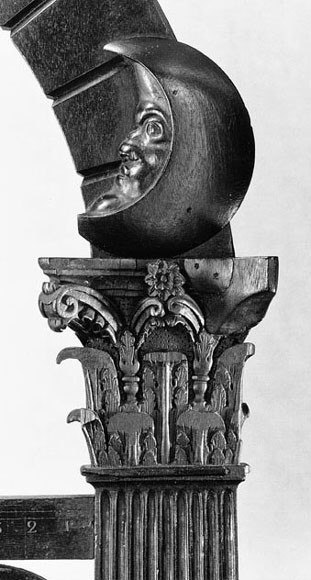
Preconservation detail of the moon on the chair illustrated in fig. 2. (Photo, F. C. Howlett.) Two coats of dark, degraded varnish are above the mahogany.

Scanning electron microscope photomicrograph of a particle taken beneath the moon’s lower lip (350x). (Courtesy, Smithsonian Center for Materials Research and Education, Smithsonian Institution; photo, Melanie Feather.)
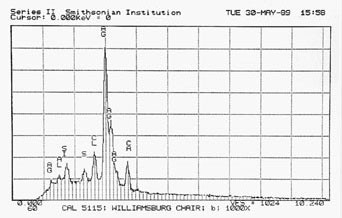
Scanning electron microscope–EDX spectrum indicating the presence of silver in the particle illustrated in FIg. 25. (Courtesy, Smithsonian Center for Materials Research and Education, Smithsonian Institution.)
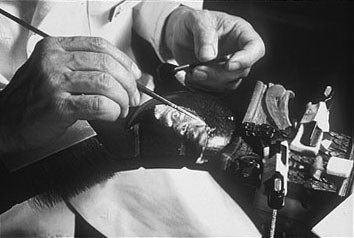
Detail of the moon on the chair illustrated in fig. 2 during treatment, showing the application of new silver leaf above an acrylic barrier coating. (Photo, F. C. Howlett.)
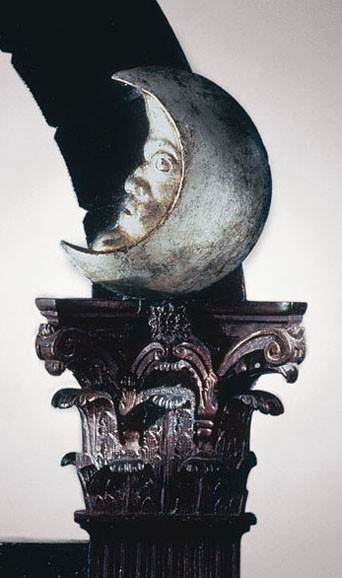
Post-conservation detail of the moon on the chair illustrated in fig. 2. (Photo, Hans Lorenz.)
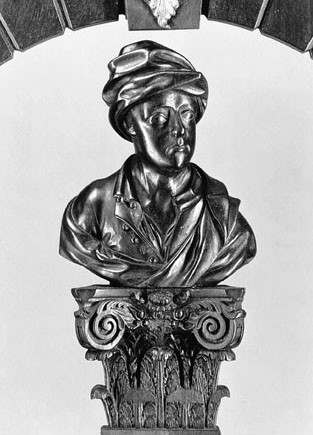
Detail of the bust of the worshipful master on the chair illustrated in fig. 2. (Photo, Hans Lorenz.)
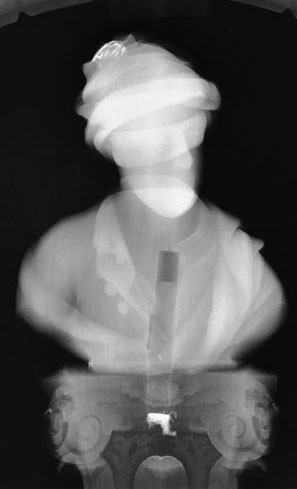
X-radiograph of the bust illustrated in fig. 29. (Courtesy, Robert Berry, Fabrication Division, Nondestructive Evaluation Section, NASA—Langley Research Center.)
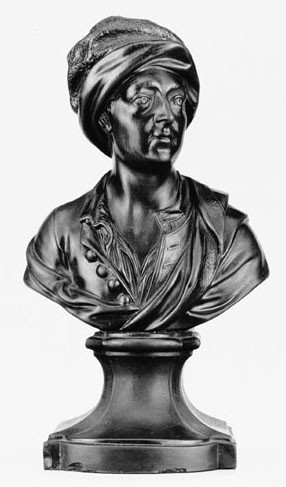
Josiah Wedgwood Factory, Bust of Matthew Prior, England, ca. 1775. Basalt stoneware. H. 9", W. 5". (Courtesy, Colonial Williamsburg Foundation; photo, Hans Lorenz.)

Detail of the scroll on the keystone of the chair illustrated in fig. 2. (Photo, F. C. Howlett.) The letters “VIR” began to appear during removal of the degraded bronze paint.
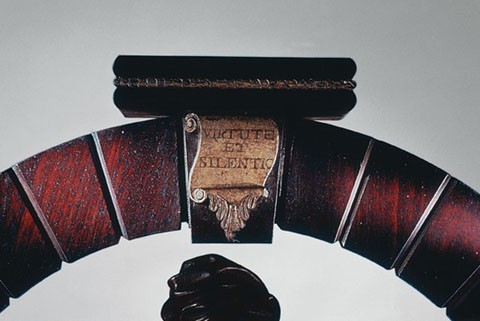
Post-conservation detail of the scroll illustrated in fig. 32. (Photo, Hans Lorenz.)
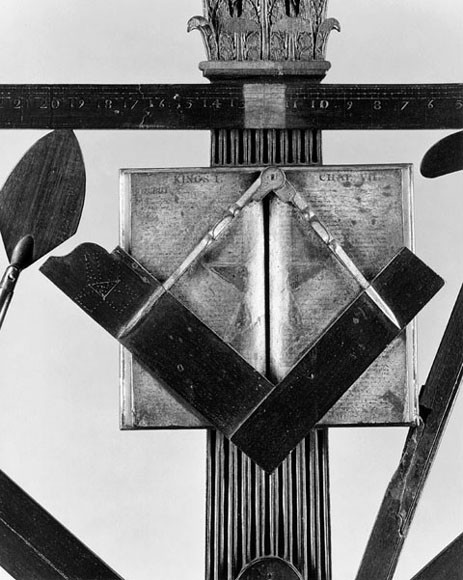
Preconservation detail of the three great lights on the chair illustrated in fig. 2. (Photo, Hans Lorenz.)

Detail of the Bible during treatment, showing removal of the degraded varnish layers. (Photo, F. C. Howlett.)

Masonic apron presented by George Washington to General William Schuyler, ca. 1770. (Courtesy, Alexandria—Washington Lodge No. 22, A.F. & A.M.; photo, Museum of Early Southern Decorative Arts.)
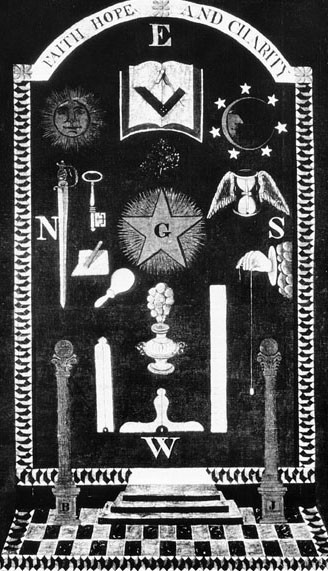
Floor cloth presented by Joseph Montfort to the Royal White Hart Lodge No. 2, Halifax, North Carolina, ca. 1765. (Courtesy, Royal White Hart Lodge No. 2, A.F. & A.M.; photo, Museum of Early Southern Decorative Arts.)
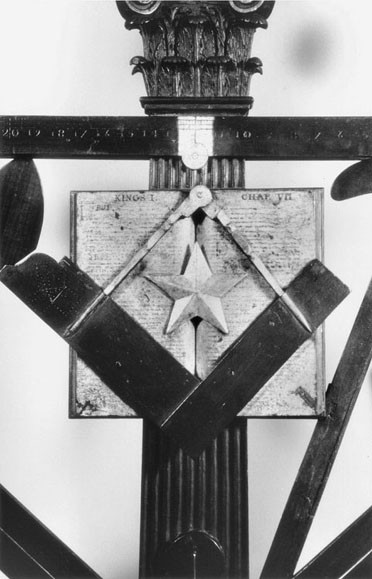
Post-conservation detail of the three great lights and the five-pointed star on the chair illustrated in fig. 2. (Photo, Hans Lorenz.)
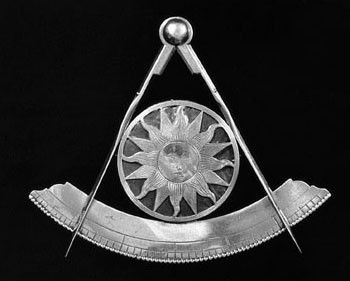
Grand master’s jewel, probably Williamsburg, Virginia, 1778. Silver gilt. H. 5 1/2", W. 6 1/4". (Courtesy, Grand Lodge of Virginia; photo, F. C. Howlett.) The jewel dates from the founding of the independent Grand Lodge of Virginia.
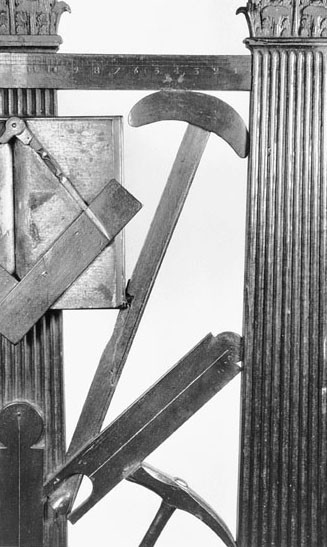
Detail of the replacement tool on the back of the chair illustrated in fig. 2. (Photo, F. C. Howlett.) The tool probably dates from the late nineteenth century.
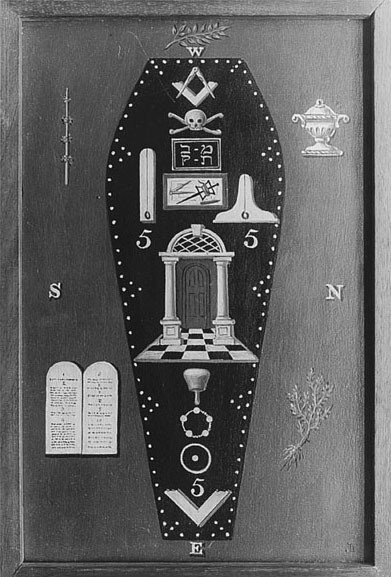
Third-degree tracing board by J. Bowring, Britain, 1819. Painted wood. (By permission of the Board of General Purposes, United Grand Lodge of England.) The English working tools of the master mason (compass, pencil, and skirret) appear in the rectangle above the arch.
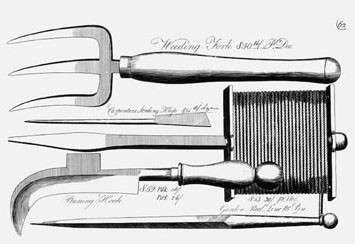
“Garden Reel” illustrated on pl. 62 of a Birmingham, England, tool catalogue, ca. 1798. (Courtesy, Peabody-Essex Museum.) In British Freemasonry, the tool described here as a “garden reel” is a version of the wooden “line” or “chalk line,” a tool given the name “skirret” by British Freemasons.
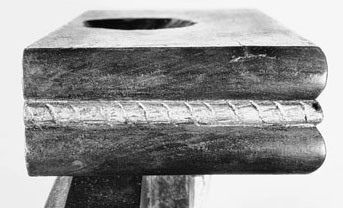
Detail of the cushion above the arch on the chair illustrated in fig. 2. (Photo, F. C. Howlett.)
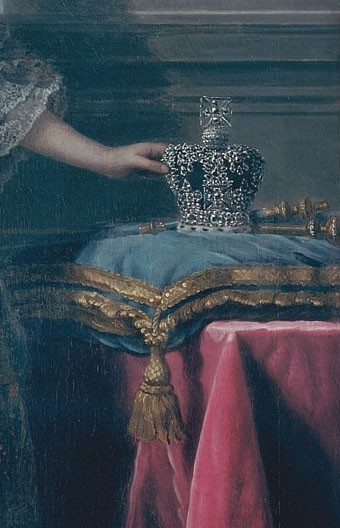
Detail of the crown and cushion in Allan Ramsay’s portrait of Queen Charlotte, ca. 1770. Oil on canvas. 96 7/8" x 61 3/8". (Courtesy, Colonial Williamsburg Foundation.)
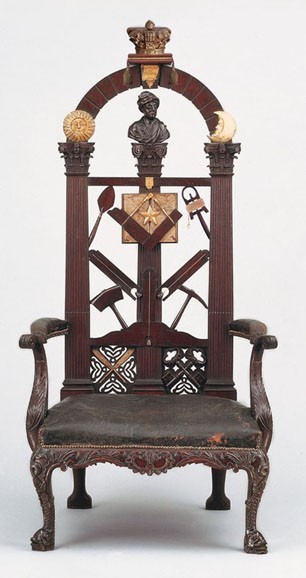
The Benjamin Bucktrout Masonic master’s chair, computer enhanced to illustrate speculations about the missing symbols. (Photography, Hans Lorenz; system work, GIST.)
Everything that strikes the eye more immediately engages the attention, and imprints on the memory serious and solemn truths. Hence Masons have universally adopted the method of inculcating the tenets of their order by typical figures of allegorical emblems.
William Preston
Illustrations of Masonry, 1772
On the evening of May 28, 1774, members of the Williamsburg Lodge of the Most Ancient and Honourable Society of Free and Accepted Masons gathered for a Master’s Lodge—the ritual reenactment of the murder, burial, and disinterment of Hiram Abif, legendary stonemason and builder of King Solomon’s Temple. Seven aspiring master Masons prepared to assume the role of Hiram Abif. Entering the lodge one at a time, each encountered three “unworthy brethren” in search of the secrets of Masonry. Refusing to reveal the mysteries of the Craft, the candidates were ritually struck down by “assassins” wielding stonemason’s tools. Wrapped in shrouds, the candidates experienced the desolation of Hiram’s burial until “resurrected” by their brethren, led by John Minson Galt, a prominent physician in Williamsburg and deputy master of the lodge (fig. 1).[1]
This ritual was not unusual during the rapid growth of the Williamsburg Lodge in the years before and during the Revolutionary War. Two candidates, Edmund Randolph and Henry Tazewell, came from wealthy Virginia families. Both were twenty years old, had recently completed legal study at the College of William and Mary, and were commencing what would become distinguished careers in public service. Randolph probably was influenced by his uncle Peyton Randolph, provincial grand master of Virginia Freemasonry, speaker of the Virginia House of Burgesses, and president of the First Continental Congress. Candidate William Yates was a professor at the College of William and Mary and son of the college’s president. During the 1770s, the Williamsburg Lodge attracted liberal-minded faculty, clerics, and students, who esteemed Freemasonry for its antiquity, enlightened rationalism, and Newtonian scientific idealism.
The next three candidates provide an interesting contrast in education, wealth, and social status. Michael McCarty worked as a guard at the powder magazine in 1762, John Lockley was a barkeeper at Mrs. Vobe’s Tavern in 1774, and, although Walter Battwell’s profession is unknown, he was not a man of means. In 1775, the lodge ordered its treasurer to “pay to Brother Battwell the Sum of Twelve Pounds for his relief . . . Brother Battwell to have a free seat in the Lodge and invited free to all feasts.” Masons believed that assisting the distressed “is a duty incumbent on all men, but particularly on Masons, who are linked together by an indissoluble chain of sin-
cere affection.”[2]
The last candidate, Benjamin Bucktrout, was neither poor nor privileged, and it is unlikely that his education approached that of Randolph, Tazewell, or Yates. Bucktrout immigrated to Williamsburg from London in 1765 and subsequently became a successful cabinetmaker and merchant, serving such distinguished patrons as Robert Carter, the Blair family, and Governor Botetourt. In the mid-1770s, Bucktrout was also one of the most active members of the Williamsburg Lodge.[3]
The admission of Bucktrout and others of lower social standing into the Williamsburg Lodge underscores a significant shift in the membership of Freemasonry. During the early eighteenth century, Freemasonry was the domain of progressive members of the social and intellectual elite, who espoused a philosophy of universal brotherhood, egalitarianism, and religious toleration. By midcentury, Masons began acting upon their ideals, as the tenets of the Ancient and Honourable Society attracted men of a lower station in life. In the words of Williamsburg Reverend James Madison, “Man, created by the great Author of all Things was formed for equality. Those artificial Distinctions which Societies introduce, Masonry obliterates. Following Nature as her Guide, she extends her Arms to all, whether the humble Cottage be their Lot, or whether raised to the most exalted stations. Benevolence, Integrity, and Charity are the only Discriminations that she knows, and these are such as Nature herself have established.”[4]
Although the American rebellion against British authority was still a few years away, a quiet social revolution had already begun, partly in the guise of Masonic ceremony and celebration. As fraternal ties united men of increasingly diverse backgrounds, Freemasons gathered to experience ancient rituals, to derive lessons from the symbols emblazoned on lodge furnishings, to listen to moral and philosophical discourse, and to feast, drink, and observe “that Harmony, Decorum, and friendly Intercourse, which characterize the Brotherhood, and are so agreeable to the Laws of Masonry.”[5]
The Bucktrout Masonic Master’s Chair
A master Mason and senior steward of the Williamsburg Lodge, Benjamin Bucktrout created the most elaborate ceremonial chair produced in the American colonies (fig. 2). This Masonic master’s chair, which probably dates between 1769 and 1775, is the only signed example of Williamsburg furniture. As such, it clearly documents cabinetmaking practices in that city and sheds light on the aspirations of eighteenth-century Freemasonry in Virginia.
Bucktrout’s Masonic master’s chair was one of several made in the South prior to the Revolution (see figs. 3-6). Although speculative Freemasonry was founded in England in 1717 and established in America by the 1730s, very little lodge furniture or three-dimensional Masonic art made before 1750 survives in England or America. A few British chairs bearing Masonic emblems date from the late seventeenth century (probably made for lodges of working, or “operative,” stonemasons), but the real tradition of ceremonial lodge furniture dates from the third quarter of the eighteenth century. In fact, the Grand Lodge of England, which chartered at least five eighteenth-century Virginia lodges, acquired its own ceremonial furniture only after building Freemason’s Hall in London in 1775.[6]
The master’s chair occupied a place of special significance within the lodge room—a carefully contrived setting symbolically representing the interior of King Solomon’s Temple. Wherever Masons met, they laid out the lodge room according to that allegorical plan, effectively conveying a sense of mystery, solemnity, authority, and tradition. Placed on the east wall of the room, the chair associated the worshipful master with the rising sun. Just as the sun was the source of celestial light, the master was a source of knowledge and enlightenment. Traditionally, three steps led up to the chair, suggesting the progression through the three symbolic degrees of Masonry (representing three levels of self-knowledge) to the state of virtue exemplified by the worshipful master.
The identity of the lodge that first owned Bucktrout’s chair is a mystery, but the chair stood for over two hundred years in Unanimity Lodge No. 7 in Edenton, North Carolina. Unanimity Lodge accepted the chair on July 6, 1778, as a gift from a ship’s captain named George Russel, who, legend states, had been entrusted with the chair by a lodge in Virginia for safekeeping during the Revolution. When the lodge in Virginia failed to reestablish, Russel presented the chair to Unanimity Lodge.[7]
Unanimity Lodge tradition maintains that Bucktrout’s master’s chair was one of three commissioned for lodges in Virginia by “Lord Baltimore.” This unlikely patron’s name is probably a corruption of Lord Botetourt, royal governor of Virginia from 1768 to 1770. A similar tradition accompanies the master’s chair made for the Williamsburg Lodge (fig. 3). Bucktrout provided furniture for the Governor’s Palace and supervised arrangements for Botetourt’s funeral. Although the governor may have commissioned the Bucktrout chair for a lodge in Norfolk, which claimed the chair in letters dated 1811 and 1815, evidence suggests that Bucktrout made it for use in the Williamsburg Lodge by Peyton Randolph, provincial grand master of Virginia.[8]
Nothing is known about Bucktrout’s training, but his master’s chair demonstrates a familiarity with urban British style. The dolphin legs are virtually identical to those of a French chair illustrated on plate 21 of the first edition of Thomas Chippendale’s The Gentleman and Cabinet-Maker’s Director (1754) (figs. 7, 8), a book that belonged to at least one other Williamsburg cabinetmaker. Similarly, Bucktrout’s Corinthian and Composite capitals are based on those in plates 4 and 5; the acanthus leaves are remarkably similar and the scribe lines on the reverse of the capitals duplicate the proportional relationships presented in the Director (figs. 9, 10).[9]
Although Bucktrout borrowed individual details from the Director, he ignored Chippendale’s design for a master’s chair (fig. 11). The Director design, though more elaborate than most extant chairs, represents the approach generally utilized by makers of Masonic furniture. The symbols—a blazing sun and the stonemason’s tools—serve as focal points, but they are grafted onto a conventional seating form. Bucktrout’s chair represents an inventive, possibly unique, departure from the standard approach to Masonic chair design. Whereas the legs, seat rails, and arms are a synthesis of London and Williamsburg stylistic details, the back is entirely symbolic. Impressively, this conceit applies not only to the ornament but also to the very structure and composition of the design.
The major framing elements of the back are symbols derived from classical architecture (fig. 12). Corinthian columns support the arch and keystone, and a central Composite column supports the bust of the worshipful master. The area within this framework is composed entirely of emblems of the Craft. In the center are the three great lights—the compass, square, and “Volume of the Sacred Law”—the most recognized symbols of eighteenth-century Freemasonry. The lights are overlaid with the five-pointed star, a juxtaposition unfamiliar to twentieth-century American Masons but of probable symbolic importance during Bucktrout’s time. Surmounting the columns are the three lesser lights—the sun, moon, and worshipful master—which comprise the secondary symbolic triad of Freemasonry. Between the columns are the working tools of the Craft: the 24" gauge, trowel, plumb rule, level, mallet, and gavel. Each tool was important symbolically and some served as “jewels”—insignias of the lodge officers. At the base are the jewels of the secretary (crossed quills) and the treasurer (crossed keys), apparently included to complement the officers’ jewels above.[10]
The Colonial Williamsburg Foundation acquired the Bucktrout chair in 1983 and began conservation in 1989. Historical research, traditional connoisseurship, and scientific analysis helped place the chair within its historical context. The conservation treatment drew upon this research and contributed to it, as new discoveries about the physical nature of the chair’s symbols gave insights into their meaning.
Origins of Masonic Symbolism
The Bucktrout chair embodies the rich, obscure tradition of Masonic symbolism, a tradition rooted in medieval stonemasonry and Renaissance Neoplatonism. Most apparent is the influence of the medieval, guildlike association of working or “operative” stonemasons. The use of masons’ tools as symbols, the wearing of aprons, the practice of gathering in “lodges,” the Hiramic legend, and the levels or degrees within the Craft—entered apprentice, fellowcraft, and master—all derive from the medieval stonemason’s trade. Fourteenth-century manuscripts indicate the practical function of the early lodges: ensuring quality workmanship, instituting wage policies, and protecting the trade’s secrets. The lodges also established guidelines for the moral conduct of members, developed trade-oriented symbols to represent desirable values, and created a mythical history that stressed the secret knowledge, honor, and antiquity of the trade.
During the seventeenth century, operative stonemasonry incorporated an amalgam of esoteric ideas from outside the trade. These ideas influenced the gradual transformation of stonemasonry from an operative craft organization into a purely speculative society, combining sociability with an allegorical system of moral instruction. The symbolism of the new “speculative” Freemasonry reflected this transformation, as the organization expanded its imagery to include a rich mixture of emblems, hieroglyphics, and symbols associated with several arcane schools of late Renaissance thought. The medieval craft organization provided a structural and symbolic foundation, but the speculative Freemasonry that developed in England and spread across the world evolved into an entirely different organization.
The transformation of stonemasonry accompanied a change in lodge membership that occurred during the seventeenth century. Early in the century, operative stonemasons, already of a higher social standing than most tradesmen, began accepting members of the gentility into their lodges. Gentlemen such as Sir Robert Moray and Elias Ashmole joined Masonic lodges during the 1640s. Both men were members of the Royal Society with strong scientific, philosophical, and antiquarian interests. In 1688, Randle Holme wrote of his decision to “honor the Fellowship of the Masons because of its Antiquity.” Masonry fed on the seventeenth-century passion for antiquity; the past was a source of fundamental truths, and the stonemasons’ lodge, through its rituals and symbols, represented an unbroken tradition of ancient, secret wisdom.[11]
The stonemasons’ association with architecture also appealed to educated gentlemen. Renaissance scholars revered Vitruvius, who believed that an architect must “be educated, skilful with the pencil, instructed in geometry, know much history, have followed the philosophers with attention, understand music, know the opinions of the jurists, and be acquainted with astronomy and the theory of the heavens.” By joining a lodge, gentlemen consciously identified themselves with the great architects—masters of many disciplines and creators of edifices intended to elevate the human spirit. The classical orders of architecture gained special significance in the symbolism of the new Freemasonry. As physical manifestations of the philosophy of the ancients, they represented important universal ideals.[12]
Another attraction was stonemasonry’s emphasis on secrecy and its association with occult practices. Among early stonemasons, cryptic signs, handshakes, and the “Mason’s word” enabled members of the transient craft organization to recognize and to communicate covertly with one another. This secrecy gave Freemasonry the aura of an occult mystery, and the Craft became associated with a number of arcane Neoplatonic philosophies.
Neoplatonists, who fused classical philosophy with Renaissance mysticism, conceived of the universe as a unity of spirit and matter. For Christian Europe, this conception represented a new way of looking at the world: Spiritual truth was no longer dependent upon divine revelation, and man could understand the metaphysical world by studying the natural world. A branch of this philosophy, Hermeticism, focused on the writings of Egyptian alchemist and astrologer Hermes Trismegistus. Renaissance antiquarians justifiably considered stonemasons’ lodges to be repositories of ancient Hermetic tradition, since stonemasons had long revered Hermes as the source of the principles of geometry.
Neoplatonists believed that the mysteries of the universe could be unraveled by combining the mathematical and scientific models of the Egyptians and the Greeks with the empirical endeavors of medieval alchemists and astrologers. This approach became a simultaneous pursuit for spiritual and worldly knowledge. The alchemist’s quest for the philosopher’s stone, the material that could change base metals into gold, became an allegory for the human quest for spiritual perfection.[13] Whether spiritual or proto-scientific, Neoplatonic philosophy was linked with symbolism. The specific symbols of the Hermeticists reflected their desire to harness the creative powers of the universe; thus, the tools of geometry (the compass and square) and astrological symbols (sun, moon, and star) had special meaning. To the Hermetic philosopher, the linkage of an evanescent idea with a material object created something greater than the idea or the object alone. As embodiments of matter and spirit, symbols contained the truth of nature and divinity (fig. 13).
The Jewish mystical literature known as the Caballa also infused Neoplatonic philosophy, eventually influencing the symbolism of Freemasonry. Central to the Caballistic tradition is the concept of an incomprehensible, infinite being, perceptible only through the symbolic grouping of divine emanations: a hierarchy of three triads (physical, moral, and spiritual) arranged on three pillars (justice, middle, and mercy), all supported by a tenth emanation (Kingdom). Known collectively as the tree of life, these emanations symbolized both the microcosm (archetypal man) and the macrocosm (universe).[14]
Symbolism pervaded Neoplatonic philosophy, embodying its essential concepts: the unity of matter and spirit, of object and idea, and of man and the universe. Symbolism gave rise to the expression of unutterable truths, the comprehension of fathomless mysteries, and the revelation of natural principles. With symbolism as their medium, the alchemists and philosophers of the late Renaissance fashioned the last of the western “holistic systems of knowledge . . . where no art, science or technology was intelligible without its cosmological, ethical, and ‘existential’ presuppositions and implications.”[15]
The pillars, triadic arrangements, celestial bodies, artisan’s tools, classical orders, and geometric designs on the back of the Bucktrout chair represent a fusion of late Renaissance mysticism with the rituals of medieval stonemasonry (see fig. 12). By the time Bucktrout made this chair, however, these symbolic vestiges of archaic philosophies had been invested with new meaning. The western world experienced a dramatic transformation during the early eighteenth century, a transformation both reflected in and fostered by Freemasonry. Significantly, much of this change was wrought by one of the last of the great alchemists—Sir Isaac Newton. Newton established the foundations for modern science, altering perceptions of the universe and of humanity in the process. Newtonian philosophy, along with concurrent strains of the new Enlightenment thinking—the religion of nature and the perfectibility of man—resonated within the lodges of the Freemasons. The old symbols and rituals of the Craft resonated as well.
Freemasonry in the Eighteenth Century
The Ancient and Honourable Society of Freemasons traces its formal organization to 1717, when four lodges assembled at the Goose and Gridiron Tavern in London to form a Grand Lodge. Freemasonry, which became the most successful of the eighteenth-century secret societies, envisioned itself as more than just a “club.” Sociability was important, but from the beginning Freemasonry established a much higher goal: the moral and spiritual development of its initiates through a universal system transcending religion, politics, and all other constructs of man. To accomplish this goal, Freemasonry adapted its long tradition of symbolism and ritual to the new philosophies of the Enlightenment.
The most influential leader in this new Freemasonry was Huguenot John Desaguliers, a member of the Royal Society and a colleague of Sir Isaac Newton. An accomplished scientist, Desaguliers was noted as the great popularizer of Newton’s scientific discoveries. By demonstrating and quantifying the force of gravity, Newton had taken the mysterious and unknowable and made it comprehensible. He discovered a natural law with profound spiritual implications, an unseen force that governed the motion of the entire universe. This finding was the single most important discovery of the age, not only as a scientific principle but as the basis for a new, idealistic way of looking at man’s place in the universe. The spiritual mysticism of the seventeenth century yielded to a new conviction in the powers of man. Mysteries still existed, but, by using reason and his five senses, man suddenly seemed capable of solving them. It followed that, by conducting human affairs according to the same natural principles at work in the universe, man could usher in a new era of harmony, happiness, and peace.
In 1721, Presbyterian cleric James Anderson began working with Desaguliers on the Constitutions of the new speculative Freemasonry. Anderson rewrote the ancient “Old Charges,” the old moral and ethical code of the operative stonemasons, to reflect the philosophical bent of the new organization and to address the new Enlightenment thinking. The Constitutions defined antiquity in terms of Newtonian philosophy, the religion of nature, and man’s Masonic progress. God, “the Almighty Architect of nature and Masonry,” appears not as a judge but as a benevolent creator who gave man a “Heart thoroughly instructed in the noble Science of GEOMETRY, for his own improvement and for the Instruction of his Descendants.” Anderson recast the world’s history as man’s creative progression towards spiritual and technological perfection (fig. 14).[16]
The new “Charges” accompanying this history advocated religious and political tolerance. The first charge simply called for belief in a supreme being and “that religion in which all men agree, leaving their particular opinions to themselves . . . whereby Masonry becomes the center of union, and the means of conciliating true friendship among persons that must have remained at a perpetual distance.” Masonry saw itself as a universal institution transcending any particular religious doctrine. This approach attracted English deists, many of whom were educated members of the gentry who eschewed religious dogma, “divine revelation,” and sectarian exclusivism. Deists professed a simple faith in the goodness, benevolence, and wisdom of their creator, perceived rationally in the order and harmony of nature. Within the established church, this Enlightenment faith became known as latitudinarianism, and it found special favor among American colonists, particularly Virginia planters. In the decade prior to the Revolution, the College of William and Mary was “the most effective academic base of American deism,” and the Williamsburg Lodge, which attracted many local scholars, served as the secular “Sanctum Sanctorum” for the practice of their faith.[17]
The second charge urged political moderation but upheld the individual’s essential freedom of opinion: “A Mason is to be a peaceable subject to the civil powers, wherever he resides or works . . . never to be concerned in plots and conspiracies against the peace and welfare of the nation.” Although a Mason who defies the state is “not to be countenanced . . . the loyal brotherhood cannot expel him from the lodge, and his relation to it remains indefeasible.” The founding members of the Craft, mostly Whigs opposed to absolute monarchy, envisioned Freemasonry as an institution transcending politics. The organization, therefore, attracted those who entertained thoughts of republicanism.[18]
Anderson’s Constitutions are crucial to understanding the transformation of Freemasonry from an operative craft into a speculative system of moral development—a system that codified the Enlightenment faith in reason and the perfectibility of man. This same faith provided much of the impetus for the tremendous social forces later expressed in the American and French revolutions and the establishment of republicanism and self-government.
The optimism of Freemasonry was based upon ideals, but it would be naive to assume that all those who took the oaths of Freemasonry were idealists. Some members were motivated more by concerns for sociability, social status, and financial advantage. Williamsburg cleric and Freemason William Bland lamented the paucity of lodges “wherein her votaries are sincere.” The visible manifestations of Masonry—processions, socializing in taverns, sumptuous feasts, self-proclaimed antiquity, tools cast as symbols, and glittering jewels—smacked of superficiality to uninitiated and “unenlightened” skeptics (fig. 15). Joseph Greene, a New England Old Light Congregationalist who opposed the optimistic deism of Freemasonry, mocked the Boston Lodge’s traditional Feast Day of St. John the Evangelist in his “Entertainment for a Winter’s Evening”: “To house of God from house of ale, And how the parson told his tale: How they return’d, in manner odd, To house of ale from house of God.”[19]
Despite such criticisms, the Craft grew throughout the eighteenth century. Freemasonry sought to be a universal institution, and in a sense it succeeded. By equating sociability with the sacred, by comparing man to the universe, by combining mystery with reason, and by fusing science with morality, the Craft encompassed nearly all of the aspirations, ideals, vanities, and contradictions of the eighteenth century.
The Symbolism of the Bucktrout Masonic Master’s Chair
Bucktrout’s chair appears calculated to promote lessons in eighteenth-century Masonic cosmology: the belief in a harmonious world where the practice of brotherly love and moral virtue exemplifies direct conformity to the laws of nature. With its architectural framework, purposeful juxtaposition of tools, celestial bodies, inscriptions, and bust, the chair has less in common with other master’s chairs than with the traditional symbolic instructional devices of Masonry—the tracing boards and floor cloths found within the lodges and the engravings accompanying Masonic texts. In a remarkable feat of design, Bucktrout successfully translated into freestanding, three-dimensional form the eighteenth-century symbolic art of Masonry—art that, because of its celestial, hieroglyphic character, appeared most often in two-dimensional form.
Pillars and Arch
Freemasonry has always glorified architecture as a sublime expression of human creativity, and the pillars and arch are quintessential symbols of the Craft. On the Bucktrout chair, the architectural elements are academically correct and structurally clever. They also have a striking graphic quality that amplifies their symbolic meaning. Masonic texts of the eighteenth century extolled both the aesthetic qualities and the inherent virtues of the five classical orders. By fusing these classical influences with the triad of pillars forming the Caballa’s tree of life, Masonry endowed its three pillars (the “supports of a lodge”) with the qualities of wisdom, strength, and beauty. The three pillars also designate the legendary grand masters—King Solomon, King Hiram, and Hiram Abif—and, by extension, the officers of a lodge.
By the early nineteenth century, the Doric, Ionic, and Corinthian orders had become formalized representations of the three pillars, but earlier artists rendered them in a variety of classical forms. For example, the master’s chairs made for Williamsburg Lodge No. 6 (fig. 3) and Fredericksburg Lodge No. 4 (fig. 4) have Ionic, Corinthian, and Composite elements arranged in different sequences. The Bucktrout chair has a central Composite pilaster flanked by two Corinthian ones (fig. 16). His composition probably had dual symbolism, representing both the three pillars of Masonry and the pillars (named Jachin and Boaz) that flanked the entrance to King Solomon’s Temple.[20]
According to Hiramic legend, King Solomon’s Temple was a repository of secret knowledge; thus Jachin and Boaz stood at the entrance to new levels of wisdom. In the Bible, they have identical capitals of “lily-work”; consequently, English artists commonly depicted them as Corinthian columns, often surmounted by globes, celestial bodies, or the arch of heaven. In a similar fashion, Bucktrout’s Corinthian pilasters act as supports for the sun, moon, and arch. The Ionic volutes of the central Composite capital, on the other hand, refer to the pillar of wisdom associated with the worshipful master, whose bust it supports.
Over time, the delicately carved capitals of the chair lost a considerable amount of detail because of their laminated construction and regular use (fig. 17). Several leaves and volutes fell off when their glue joints failed, and other losses occurred because of the carving’s inherent fragility. The extreme undercutting necessary to render acanthus foliage properly produced numerous curls of weak, short-grained mahogany. To preserve the historic character of the chair, the curatorial and conservation staff chose to leave some of the old losses untouched as evidence of the chair’s regular use and to repair only the most visually objectionable ones (figs. 18, 19).[21]
Bucktrout’s rusticated arch of heaven is composed of two arc-sawn mahogany boards lap-joined behind the keystone. To Bucktrout and his Masonic brethren, smooth-dressed “stones” represented perfect ashlar—the ideal state of virtue and the lifelong goal of every Mason. Entered apprentices identified themselves with rough ashlar, a coarse, unformed block of stone, which was neither intrinsically moral nor innately depraved. The creation of perfect ashlar was a Lockean metaphor for human development; by progressing through the Craft degrees, “the rough external is smoothed off, and beauties, till then unknown, rise full to . . . view.” The Bucktrout chair goes beyond the theme of individual perfectibility, however, to serve as a reminder that men could “bring their ideas . . . conduct. . . and institutions . . . into harmony with the universal natural order.” The arch’s conjoined blocks of perfect ashlar represent Masons joined in universal brotherhood—an embodiment of the Enlightenment vision of the “Heavenly City” on earth.[22]
The association of whole numbers with mystical powers is another component of Masonic symbolism. A vestige of the occult arts of the late Renaissance, Masonic number systems drew on the Pythagorean mysticism of the Hermeticists and on the secret numerical/alphabetical equations of the Caballa. In the Pythagorean system, odd integers represented male attributes, a distinction that probably accounts for their prevalence in Freemasonry.
During the eighteenth century, Masonry’s mystical numerology was tempered by rationalism, but it never disappeared. The frontis of Thomas and Batty Langley’s The Builder’s Jewel (1741, 1747) has several allusions to the number three, the most perfect number in the Masonic system (fig. 20). Nearly all of the symbols occur in triadic arrangements, and each of the three pillars is labeled with one of the significant numbers of Freemasonry, III, V, and VII. Above an acacia branch marking the grave of Hiram Abif is the number 15, representing the sum of the three significant numbers as well as the fifteen days the body of the murdered master lay undiscovered.
Obvious triadic arrangements on the Bucktrout chair are the three great lights (Bible, compass, and square) and the three lesser lights (sun, moon, and worshipful master). Other numerical allusions are the nine flutes on each pillar, a possible reference to perfection, to the nine muses, to the nine worthies of Masonic legend, and to the celestial sphere (360 degrees: 3 + 6 + 0 = 9). There are twenty-seven flutes in all, a number of great significance since it is the product of three raised to the third power. The pillars taper to a width of three inches at their capitals, the same width found on the curved elements comprising the arch of heaven. The seven segments on each half of the arch suggest creation as well as the number of years required to build Solomon’s Temple; and in its entirety, the fifteen blocks of perfect ashlar comprising the arch (including the keystone) recall the fifteen days of Hiram Abif’s interment, the fifteen elect who founded the Society of Freemasons, and the fifteen steps of the winding staircase leading toward a life of virtue (the first three steps symbolize the three ages of man and the three degrees of Masonry, the next five represent the five senses and the five orders of architecture, and the final seven symbolize the seven arts and sciences and the seven planets).[23]
The Three Lesser Lights: The Sun, the Moon and the Worshipful Master
In a sermon delivered at Williamsburg Lodge on December 27, 1775, Reverend William Bland remarked:
mingled with the mighty Chaos, [light] moderated its Convulsions, and gave the whole Body a Bias, to receive such Impressions as unbounded Wisdom should afterward prefer. . . . In strict Affinity to Light doth Masonry step into the Dissentions and Animosities amongst Men. . . . Need I be asked, Why we revere the Sun and Moon, seeing that the Former is the Source of Light, the Latter its Subordinate Minister.[24]
The sun, the moon, and the worshipful master were the symbolic focus for Masonry’s reverence for light, yet this reverence suffused the entire institution. The Feast Days of St. John the Baptist and of St. John the Evangelist, for instance, marked the yearly progress of the sun, falling on the summer and winter solstices, respectively. Similarly, the orientation of the lodge to the east, with obeisance to the south and west, paid heed to the sun’s daily travel.
Thomas Paine, who called the sun “the great emblematical ornament of Masonic lodges and Masonic dresses,” observed that “Masonry . . . is the remains of the religion of the ancient Druids; who, like the magi of Persia and the Priests of Heliopolis in Egypt, were priests of the sun. They paid worship to this great luminary, as the great visible agent of a great invisible first cause.” By revering the sun and the moon, Freemasons were practicing the religion of nature. This was not necessarily the pantheism of the Druids, but rather the English deism that transcended, and in many individuals supplanted, the traditions of Christianity. Deified nature was the source of light, light was the source of reason, and reason was the source of truth.[25]
Within the Freemasonic scheme of natural religion, the worshipful master was an intermediary between nature and the individual Mason. In a metaphor derived from the craft tradition, the worshipful master embodied the wisdom and knowledge obtained through years of labor. He also represented cumulative human knowledge: the sum total of man’s application of reason to the study of nature. By following the light of the worshipful master and by studying his teachings, the Mason could speed his progress toward virtue. The symbol of the worshipful master could call to mind King Solomon, as in the ritual of the third degree, or it could evoke the character of a more recently departed patriarch. In his Feast Day sermon on December 27, 1775, William Bland extended the language of light beyond the sun and the moon to exalt the late worshipful master of Williamsburg Lodge, Peyton Randolph, “as a bright Exemplar, to imitate and admire. . . . All North America was under his wing, but we his peculiar Care. . . . I congratulate my brethren that we once had Such a head and such a Father.”[26]
Given the importance of light to eighteenth-century Freemasonry and its embodiment in the symbols of the sun, the moon, and the worshipful master, the Bucktrout chair appeared very dim when Colonial Williamsburg acquired it (fig. 21). Subsequent examination, however, revealed that the chair initially had three types of gilding: burnished water gilding, oil gilding, and shell gold (gold powders on size). These materials and their skillful application suggest that the work was done by an ornamental painter or a carver and gilder such as George Hamilton. In the July 28, 1774, issue of the Williamsburg Gazette, Hamilton advertised, “GEORGE HAMILTON, CARVER and GILDER, just from Britain, and now in this City, hereby informs the Publick that he intends carrying on his Business in all its Branches.”[27]
Hamilton worked for cabinetmaker Edmund Dickinson, who succeeded Bucktrout as the master of the Hay shop. Like Bucktrout, Dickinson was an active member of the Williamsburg Lodge. Hamilton may also have been a Mason, for a George Hamilton appeared as a visitor at lodge meetings six times between August 1774 and February 1775. Bucktrout, who never advertised gilding, may have required Hamilton’s services to complete his master’s chair.[28]
Layers of tarnished nineteenth- and twentieth-century bronze paint obscured the brilliance of the sun, and areas of long-lost gesso and gold scarred the expression on its face (fig. 21). A small finish sample taken from the sun’s cheek revealed that the original surface was water gilded (three to five coats of gesso laid on the wood, followed by a thin layer of red bole topped with burnished gold leaf) and that earlier restorers had added a layer of oil gilding (oil size and gold leaf) and, more recently, a layer of bronze paint (fig. 22). To preserve the historic integrity of the fragmentary water gilded surface, we removed the degraded bronze paint and left the oil gilding. Once cleaned, an acrylic coating consolidated the surface and gave the gold a luster that resembled the original water gilding (fig. 23).[29]
The moon presented a set of problems entirely different from those of the sun (fig. 24). Like the rest of the chair, this dark mahogany crescent had two later layers of opaque varnish. Common sense suggested that the moon was decorated originally, and upon close inspection we noticed a few bits of pale-colored residue lodged below the lower lip. Suspecting that these fragments were vestiges of silver-gilded decoration, we arranged for an examination of the chair at the Smithsonian Institution’s Conservation Analytical Laboratory.
Examination began using an X-ray fluorescence object analyzer, an instrument used to determine the atomic elements of high atomic weight present on an object’s surface. When the X-ray beam strikes the surface, each atomic element fluoresces differently. The sensor takes in the fluorescence of all the elements present, and the unit produces a printout of the combined spectra on a single graph. With computer assistance, the spectral peaks for each element present are readily distinguished.
The indistinct substance below the moon’s lower lip contained calcium, iron, lead, and silver. This result tentatively confirmed our hypothesis; but the silver spectral peaks from the moon were minimal, so we decided to remove a small sample for more intensive examination (fig. 25). A scanning electron microscope incorporating energy dispersive analysis (SEM-EDX) yielded solid proof of silver gilding. The presence of calcium, lead, and iron also supported this conclusion, since these materials are found in gesso and bole (fig. 26).
Given this evidence, we decided to resilver the moon. To preserve the minute fragments of the original surface and the later varnish layers, we applied four coats of acrylic resin. As each layer dried, we abraded it with fine finishing paper to provide a smooth, bole-like surface for the silver leaf. A fine mist of solvent sprayed onto the acrylic surface made it slightly tacky, permitting the leaf to be laid in the traditional manner (fig. 27). After the surface dried, we distressed the leaf, toned it with watercolors, and coated it with shellac to impart color and prevent tarnishing (fig. 28).[30]
The renewed brilliance of the sun and the moon produced an unforeseen imbalance within the triad of the three lesser lights. The bust of the worshipful master, a focal point in the entire composition of the back, seemed dark in contrast to its celestial companions (fig. 29). X-radiography revealed a small area of opacity in the tassel of the master’s turban, which suggested the presence of a heavy metal pigment (fig. 30). Upon close examination of the tassel, we found remnants of early paint and, using a simple chemical test, identified it as lead white. Microscopic samples from other areas of the bust revealed no additional pigments. Although it is possible that the tassel alone was painted, it is more likely that the entire bust was originally decorated and that it subsequently received a scouring like the moon. Since analysis was inconclusive, however, the bust remains unpainted.[31]
A ceramic copy of the marble bust of poet and philosopher Matthew Prior in Westminster Abbey probably served as the model for Bucktrout’s bust of the archetypal worshipful master (fig. 31). If so, Bucktrout may have attempted to simulate its stonelike surface. Lead white would have made an excellent ground coat for a marbleized surface, and the luminous quality of stone would have enhanced the visual and symbolic power of the three lesser lights; moreover, the implicit reference to the Craft of stonemasonry would have been obvious to lodge members.
Virtute et Silentio
Prior to treatment, tarnished bronze paint obscured the original surface of the small carved scroll on the keystone above the bust. During a test cleaning, the letters “VIR” began to emerge (fig. 32). By revealing the hidden inscription, we hoped to identify the lodge that owned the chair originally. Instead, we uncovered a Latin expression common on Masonic medals from the third quarter of the eighteenth century: “Virtute et Silentio”—by virtue and silence (fig. 33). In 1774, Philip Vickers Fithian of Westmoreland County, Virginia, observed his friend, Joseph Lane, “drest in black superfine Broadcloth; Gold-Laced hat; laced Ruffles; black Silk Stockings; & to his Broach on his Bosom he wore a Mason’s Badge inscrib’d ‘Virtute and Silentio’ cut in a Golden Medal!”[32]
Virtue was a pervasive theme in eighteenth-century moral, ethical, and religious texts and in the literature and iconography of Freemasonry. In 1777, the new president of the College of William and Mary, Reverend James Madison, exhorted his Williamsburg brethren “to raise a lasting monument of Worth upon the Basis of Virtue supported and adorned by the grand Pillars of Charity, Benevolence and Friendship.” To eighteenth-century Freemasons, the concept of virtue differed radically from that preached by dissenting Protestants. Fithian recorded the opinions of his friend, Lane, who criticized Virginia Anabaptists for “destroying pleasure in the Country; for they encourage ardent pray’r; strong and constant faith, & an entire banishment of Gaming, Dancing, and Sabbath-Day Diversions.” Lane probably agreed with fellow Mason Benjamin Franklin, whose benevolent creator “delights in the Happiness of those he has created; and since without Virtue Man can have no Happiness, . . . let me resolve to be virtuous, that I may be happy, that I may please Him.”[33]
Enlightenment thinkers like Franklin merged the classical model of virtue with eighteenth-century notions of sociability: The virtuous man achieved personal happiness and extended it to the lives of others by serving the public good. The Reverend Madison asked, “what objects are more worthy of the Wise and good . . . than those which lead us to promote disinterested Virtue, and to diffuse the stream of Happiness into every Heart . . . Men of such Character . . . will manifest by . . . generous and worthy actions, that they live not for themselves but for their Country the World.”[34]
The juxtaposition of virtue and silence illustrates one of the greatest paradoxes of eighteenth-century Freemasonry. Although virtue was a means of uniting humanity, “Silentio” alluded to Freemasonry’s legendary secrecy and exclusivity. The quality of virtue, like fraternal membership, could thus not extend to all humanity, for “the great part of mankind is not fit to be members.” In 1772, William Preston wrote: “Were the privileges of Masonry to be common, or indiscriminately bestowed, the design of the institution would be subverted; for being familiar, like many other important matters, they would soon lose their value, and sink into disregard.” Although the social boundaries of eighteenth-century Freemasonry gradually expanded, the organization maintained its status as a secret, exclusive organization. The brotherhood may have extended universal love and membership to “the distant Chinese, the wild Arab, or the American savage,” but it excluded Africans, women, and those without property.[35]
The Three Great Lights and the Five-Pointed Star
The three great lights—the compass, the square, and the “Volume of the Sacred Law”—became a unified symbol about 1760. After that time, no lodge could operate unless these symbols were present in the furnishings. Their juxtaposition served to illustrate the essentially personal nature of adherence to Masonic principles. As emblems of inner spiritual guidance, they symbolized the work of the individual Mason in his progress toward wisdom and virtue (fig. 34).[36]
To eighteenth-century Freemasons, the symbolic significance of the three great lights transcended any specific moral doctrine or religious dogma. For this reason, the “Volume of the Sacred Law” represented not only the Bible of Christianity but also the universal truths contained within the scriptures of all religions. As William Preston stated in 1772, “Men of the most opposite religions, of the most distant countries and of the most contradictory opinions, are by [Masonry] united in one indissoluble bond of unfeigned affection.”[37]
By eschewing dogmatism, Freemasonry sanctioned individual interpretations of the three great lights and other symbols. Christian interpretations were certainly possible. In his Spirit of Masonry (1775), William Hutchinson wrote:
The SQUARE will teach us to square all our actions. . . . Our behavior will be regular and uniform, not aspiring at things above our reach, nor pretending to things above our finite capacities. . . . The COMPASSES will inform us that we should in every station learn to live within proper bounds, that we may, therefore, be enabled to contribute to the relief of the necessities and indigencies of our fellow-creatures. Hence we shall rise to notice, live with honour, and make our exit in humble hopes of compassing what ought to be the main pursuit of the most aspiring genius, a crown of glory.
For Hutchinson, these Masonic symbols embodied “divine truths” and provided direction on his Christian path toward the light.[38]
In contrast, the designer of the Bucktrout chair probably intended a more universal interpretation of the three great lights. The “Volume of the Sacred Law” on the chair is a carved and painted Bible—the sacred text one would expect to find in a colonial American lodge—but it is open to I Kings, Chapter VII, which recounts in detail the construction of King Solomon’s Temple. Freemasonry traces its institutional origin to this event, and the Biblical account serves as the foundation for many of the great Masonic symbols and legends. The text, simulated on the Bucktrout chair, details the floor plan of the Temple and the orientation of its rooms—the prototype for every Masonic lodge. It also describes the ornament of the Temple, including the important pillars, Jachin and Boaz, and details events that formed the legend of the grand master, Hiram Abif.
It would be difficult for a Christian moralist to derive a lesson from I Kings, Chapter VII. The language is purely descriptive in its delineation of the form and dimensions of the Temple rooms, in its depiction of the elaborate interior ornamentation of the building, and in its discussion of the skills in woodworking, bronze casting, stonemasonry, and goldsmithing utilized by Hiram and the Temple builders. The emphasis is on human skill, industry, and ingenuity—on man as a being capable of divine creativity, building a structure dedicated to his own glory and to the glory of the “Grand Architect.”
The compass and square on the Bucktrout chair also reflect this creative function. The square represents man’s activities within the physical world, his moral nature, whereas the compass represents his spiritual side. Working together, they become positive tools for the moral and spiritual growth of the individual Mason. This concept is reinforced by the illustration of Euclid’s forty-seventh proposition, incised on the blade of the square. To the eighteenth-century Freemason, this geometric representation of the Pythagorean theorem depicted a mathematical discovery of simple logic and beauty. As a clear example of natural law, it offered a glimpse of divine perfection.
The square and compass were essential tools for making the forty-seventh proposition comprehensible. By applying the rational science of geometry to his own life through the use of his square and compass—squaring all of his actions while enlarging the circle of his spiritual world—the Mason could work to achieve consonance with natural principles and, ultimately, to attain a life of divine perfection. In Illustrations of Masonry, William Preston wrote:
By geometry, we may curiously trace Nature through her various windings, to her most concealed recesses. By it we may discover the power, the wisdom, and the goodness of the Grand Artificer of the Universe, and view with amazing delight the beautiful proportions which connect and grace this vast machine. By it we may discover how the various planets move in their different orbits, and mathematically demonstrate their various revolutions. . . . Numberless worlds are around us, all framed by the same Divine Artist, which roll through the vast expanse and are all conducted by the same unerring law of Nature. When such objects engage our attention, how must we improve, and with what grand ideas must such knowledge fill our minds![39]
The painted lettering and inscribed illustration of Euclid’s forty-seventh proposition thus link the three great lights on the Bucktrout chair with Newtonian philosophy. Small physical clues such as these often have a marked effect on the interpretation of an object, yet after years of use and deterioration their significance may be overlooked. The preservation and stabilization of these and similar bits of evidence are, consequently, paramount in conservation treatments.
Removal of the compass and square permitted a better assessment of the Bible’s fragile surface and the outline of its missing five-pointed star. In the process, it became apparent that the compass was an exact copy of a working tool, complete with movable, hinged arms. Both arms were missing their points, but they retained original oil gilding under later coats of bronze paint.
The Bible had suffered paint losses around the lettering of the chapter heading as well as in areas of the simulated text (fig. 35). Overall, the deteriorated paint had a fine craquelure and was obscured by two coats of a dark, degraded resin varnish. X-ray fluorescence and chemical tests revealed that the paint on the Bible was lead white in oil. The brown-black letters on the gesso had partially dissolved into the degraded varnish layers. As a result, removing the varnish required a combination of solvent swelling and careful mechanical removal around the perimeter of each letter. Once cleaned, two very thin coats of acrylic resin consolidated the surface, and acrylic emulsion paints and watercolors disguised the most disturbing losses.[40]
The five-pointed star originally positioned at the center of the Bible is not an important symbol in American Freemasonry; however, the star appears frequently in Masonic art from the second half of the eighteenth century. For example, a star appears below the three great lights on an apron presented by George Washington to his staff officer, General William Schuyler (fig. 36), and a blazing five-pointed star imprinted with the letter “G” predominates the imagery of a British floor cloth presented by Joseph Montfort to the Royal White Hart Lodge in Halifax, North Carolina (fig. 37).[41]
Among other things, the star was a symbol of the five points of fellowship, the points of bodily contact used to physically raise a candidate to the third or master’s degree. Each of the five points is associated with a particular duty of the master Mason regarding the welfare of his brethren, so the star became a symbol of brotherly love. Illustrative of the multidimensional nature of Masonic symbols, the star also combines the symbol of archetypal man (when viewed as a stylized human figure) with that of a celestial body. The star thus speaks to the microcosm-macrocosm relationship inherent in Newtonian philosophy—the conduct of human life according to the natural laws of the universe.[42]
Two types of five-pointed stars appear in Masonic symbolism. The most common is the pentalpha, an ancient talisman of health comprised of three open, interlaced triangles formed by five interconnected lines. The pentalpha appears in Virginia iconography on the back of the master’s chair belonging to Williamsburg Lodge No. 6 (fig. 3); however, the physical evidence on the Bucktrout chair is inconsistent with an openwork design. Instead, we made a solid, faceted star, a three-dimensional form in keeping with the other carved elements of the chair. Bronze paint overruns from a nineteenth- or twentieth-century touchup outlined the star’s position on the Bible, suggesting that it had been gilded like other elements on the chair. The star thus received water gilding much like the original surface of the sun, artificial wear to mute the surface, toning with acrylic emulsion paints, and a coat of shellac to harmonize it with its surroundings (fig. 38).[43]
After conservation, the juxtaposition of the newly constructed gilded star with the compass and square suggested the form of an esteemed officer’s jewel, much like the jewel devised in 1778 (the year Virginia lodges broke all ties with British Freemasonry) for the grand master of the newly independent Grand Lodge of Virginia—the blazing sun, compass, and quadrant (fig. 39). The five-pointed star, square, and compass, though unfamiliar to American Masons, became the jewel of English provincial grand masters in 1814 after the formation of the United Grand Lodge of England. Evidence exists that indicates earlier British use of the jewel as well, for it appears on the crest of a master’s chair in the Royal White Hart Lodge in Halifax, North Carolina (fig. 6). This chair was used by Joseph Montfort, provincial grand master of North Carolina. Virginia’s provincial grand master, Peyton Randolph, wore a jewel indicative of his status. Following his death, Mrs. Randolph presented his “Provincial Grand Master’s Jewel, Sash, and Apron,” to his Williamsburg brethren. The five-pointed star, square, and compass on the Bucktrout chair, therefore, strongly suggest that it was made for Randolph’s use in the Williamsburg Lodge.[44]
The presence of two master’s chairs in the Williamsburg Lodge is in keeping with its pre-Revolutionary status as the premier lodge in Virginia and with the membership of two masters. When Randolph assumed the title of provincial grand master in 1774, the Williamsburg Lodge elected John Blair to be its master. Both Randolph and Blair attended a lodge held on July 5, 1774. On that date, the Proceedings of the Williamsburg Lodge refer to Randolph as “P. G. M.” and to Blair as “M.” Also present at that meeting was Philadelphia artist Charles Willson Peale, who had come to paint a full-length portrait of Randolph seated in his master’s chair. The painting, later given to the Library of Congress, was destroyed during the mid-nineteenth century.[45]
The Missing Tool
Although the original symbols present on the Bucktrout chair held multiple layers of meaning for eighteenth-century Freemasons, an odd replacement tool added in the late nineteenth century probably would have been unfamiliar to them (fig. 40). The long-handled object installed diagonally to the right of the Bible vaguely resembles a Mason’s rake, but the rake had little symbolic importance when the chair was made. Glue lines, nail evidence, and an original mortise indicate that the orientation of the original tool echoed the position of the trowel; however, the mortise dimensions and the attachment points differ, which suggest that the missing component was a different tool.
The missing tool was probably one of the “working tools” of Freemasonry, as are all the others on the chair. In England and America, “working tools” were divided into three levels, each embodying the moral virtues ascribed to one of the three symbolic degrees of Masonry: entered apprentice, fellowcraft, and master Mason. Since the early nineteenth century, English and American Freemasons have employed nearly identical “working tools” for their entered apprentice and fellowcraft degrees, but the tools for the master Mason differ significantly. The American master Mason has a single “working tool”—the trowel. The English master has three—the compass, pencil, and skirret.[46]
Masonic historian Albert Mackey described the skirret as “an implement rotating on a center pin, whence a line is drawn, chalked, and struck to mark out the ground for the foundation of the intended structure.” Early nineteenth-century English Masonic illustrations of the skirret confirm it to be a tool for laying line, consisting of a reel on a spindle above a projecting handle or spike (fig. 41). Such an implement could fit into the space for the missing tool on the Bucktrout chair. Its rectangular head would harmonize with the flanking trowel and provide a counterbalance to the mallet on the lower left. More importantly, the skirret’s projecting pin would fit the attachment outline on the pilaster, and its reel would align with the mortise below the 24" gauge.[47]
Unlike the other tools on the chair, the skirret does not appear in any known eighteenth-century illustrations of Masonic symbols, nor was it an implement used by medieval stonemasons. Its origin is unknown, but given the importance of antiquity to Freemasonry, the skirret may emulate a tool discovered during eighteenth-century explorations of ancient Egyptian, Greek, or Roman archaeological sites. The earliest non-Masonic depiction of a skirret-like tool dates to about 1798 (fig. 42). A similar undated example of this tool (Colonial Williamsburg Foundation) is referred to as a “line” or “chalk line.” Curiously, the term “skirret” is associated only with British Freemasons, who coined the name early in the nineteenth century.[48]
The new name probably helped distinguish the symbolism of the skirret, a tool for laying horizontal lines, from that of the “line” or “plumb,” a tool used to establish verticality. Evidence of confusion concerning these “line” tools is apparent in Hutchinson’s Spirit of Masonry: “The Line should make us pay the strictest attention to that line of duty which has been given us, or rather which was marked out to us, by our great Benefactor and Redeemer.” Hutchinson’s words foreshadow an early nineteenth-century reference to the symbolism of the skirret: “The Schivit Line represents the strict and undeviating line of duty marked out for our pursuit in the Volume of the Sacred Law.” Both passages suggest a horizontal “line of duty” to be pursued in the physical world.[49]
Hutchinson symbolically moves the same “line” to a vertical orientation: “This line, like Jacob’s ladder, connects heaven and earth together; and, by laying hold of it, we climb up to that place where we shall change this short line of time for the never-ending circle of eternity.” This quote almost certainly refers to a “plumb,” a simple tool consisting of a string tied to a lead weight, used to establish a vertical line. Hutchinson’s extraction of “horizontal” and “vertical” moral lessons from a single implement probably reflects his genteel distance from operative stonemasonry. Such confusion could have prompted the United Grand Lodge to distinguish the horizontally employed “skirret” from its vertical counterpart.[50]
The tool missing from the Bucktrout chair may have been an early interpretation of a skirret, removed when it no longer held meaning in American Freemasonry. In addition to the physical evidence, the hierarchical arrangement of the “working tools” on the back supports this supposition. At the base are the mallet and the gavel, which have served as first-degree tools in both England and America. On the next level are two plumb rules, a level, and a square, the second-degree “working tools” in both countries. At the third level are the trowel and the compass, master Mason’s tools from America and England respectively. The skirret, a third-degree tool and a “line” symbol absent on the chair, would be an appropriate substitute for the replacement tool. The entire arrangement of the chair back, then, much like illustrations found elsewhere in Freemasonry, would symbolize the progression of the individual Mason upward through the three degrees toward the light provided by the sun, moon, and worshipful master, all occurring under the arch of heaven.
An Emblem of Royalty
Despite the profusion of symbols on the Bucktrout chair, its design is incomplete. The uppermost component, an object that once rested on the cushion above the arch, is missing. The cushion has a carved and gilded, braided cord with tiny brass loops that probably held tassels (fig. 43). Tassels and cords, depicted on eighteenth-century English tracing boards (symbolic instructional devices for entered apprentices), represented, among other things, “the universal bond by which every Freemason ought to be united to his Brethren.”[51]
Cushions, however, served not as symbols but as displays for the most revered items of a lodge during processions and ceremonies. Preston’s prescribed procession for the “Ceremony of Laying the Foundation Stone” included the “Bible, Square and Compass, on a crimson velvet cushion, carried by the Master of a Lodge.” The cushion on Bucktrout’s chair retains remnants of red paint (iron oxide) in keeping with Preston’s description, but it is unlikely that this cushion bore a Bible, square, and compass, since these elements appear elsewhere on the chair.[52]
A half-circle scribed into the cushion’s top surface and outlined by a few forged nail shanks almost certainly registered the base to a carved crown. A crown on the arch of the Bucktrout chair could associate the chair with Royal Arch Masonry. If so, this feature may be a clue to the original owner of the chair, since only lodges chartered by Scotland’s Grand Lodge or the English “Antient” Grand Lodge typically conferred Royal Arch degrees.
It is more likely that the crown simply reflected pre-Revolutionary Masonic respect for the British monarchy. Eighteenth-century, British royal portraits often depicted monarchs posed next to their crowns, which almost invariably rest upon tasseled cushions (fig. 44). In spite of its Whiggish associations, British Freemasonry maintained favor among the nobility, who traditionally served as the grand masters of both the “Antient” and Modern branches of the Craft. In 1790, the Modern Grand Lodge elected the Prince of Wales as grand master and ordered a suite of furniture to commemorate the event. Above an arch on the grand master’s chair sat a cushion bearing a crown and the Prince of Wales plumes.[53]
The colony of Virginia maintained official loyalty to the Crown until a very late date. The Williamsburg Lodge held a ceremony to lay the cornerstone of the new Capitol Landing bridge in October 1774, just after Peyton Randolph presided over the First Continental Congress. The medal laid beneath the cornerstone was inscribed, “Georgio Tertio Rege/ Comite Dunmore Profecto/ Peyton Randolph Latomorum/ proside Supremo/ Johanne Blair Proside A. L. 5774.”[54]
When the break from Britain finally occurred, it happened quickly. Late in his life, Edmund Randolph recalled the fervor of the first days of the Revolution: “Not a vestige of the emblems of royalty was tolerated where the public voice could be brought to act upon it. The wall of the House of Burgesses . . . was decorated with several of them. The chair in which the speaker sat, now filled by the president of the Convention, had a frontispiece commemorative of the relation between the mother country and the colony. These had been criticized before any formal act of reprobation was taken, and all of them were at different times effaced.” Ironically, the crowning piece of evidence for the missing element may be its disappearance.[55]
The Chair as a Symbol
The Masonic membership of Benjamin Bucktrout, like that of many other tradesmen, may have been a quest for improved social and financial standing. Indeed, a 1796 description of Bucktrout reveals that he had exchanged “his old greasy leather indispensibles and white cap” for a “scarlet waistcoat and . . . neat wig.” At the outset of the Revolution, however, he demonstrated his “Public Spirit and Ingenuity” by building, at his own expense, a hand-mill to provide gunpowder for the Virginia militia. From 1777 to 1779, he served as purveyor of hospitals for the State of Virginia, and later in life he served as surveyor and commissioner of taxes for the city of Williamsburg. Though his activity as a Mason waned in his later years, he maintained the respect of his Masonic brethren, who invited him to their annual Feast Day of St. John in June 1812, the year before his death.[56]
Benjamin Bucktrout’s personal interpretation of the symbols on his chair is unknown; nonetheless, the symbols on his master’s chair connected eighteenth-century Masons such as Bucktrout with ancient traditions and an influential system of moral guidance. Through the study and conservation of this chair we are “admitted into the mysteries” of their minds and motivations. In its entirety the chair symbolizes the ideals, values, and paradoxes of eighteenth-century Freemasonry, an organization that systematized and promulgated many of the principles of the British Enlightenment (fig. 45). This optimistic philosophy promoted ideas of tolerance, individual responsibility, and public service—ideas that must have influenced the lives of Bucktrout and his brethren, much as they contributed to the formation of the new republic.[57]
ACKNOWLEDGMENTS
For assistance with this article the author thanks Marie Barnett, Robert Berry, Melanie Feather, Jay Gaynor, Wallace Gusler, John Hamill, Ronald Hurst, and Albert Skutans. I am especially grateful to Iris Heissenbuttel for her support and encouragement throughout this project.
On December 30, 1773, the Virginia Gazette reported:
Last Monday being the Feast of St. John the Evangelist, the ancient and honourable Society of Free and Accepted Masons, all habited alike, and in the proper insignia of their Order, went in Procession from their Lodge in this City to Bruton Church, where an excellent Discourse, delivered by the Reverend Mr. Andrews, a brother Mason, was preached. . . . After divine Service, they returned to their Lodge, and dined together; after which they gave a Ball and elegant Entertainment to a Number of Ladies, and spent the Evening with that Harmony, Decorum, and friendly Intercourse, which characterize the Brotherhood, and are so agreeable to the Laws of Masonry.
Reverend Andrews was a professor of moral philosophy, and later of mathematics, at the College of William and Mary. Other attendees included the clerk of the Governor’s Council, two additional clerics, a cabinetmaker, a wigmaker, a ferry owner, a physician, the former mayor, a merchant, a musician, a tavern keeper, two silversmiths, and several members of the landed gentry. The attendees are listed in MWLM, p. 14; the biographical information came from historian Harold B. Gill and from Kidd, Freemasonry in Williamsburg, pp. 87–131.
The July 6, 1778, Minutes of Unanimity Lodge No. 7 record: “Justices gave leave that the Lodge might be held in the Courthouse . . . it was accordingly moved, when Br Russel presented the Lodge with an Elegant Master’s Chair for which he received thr Sincere Thanks” (as quoted in Bradford L. Rauschenberg, “Two Outstanding Virginia Chairs,” Journal of Early Southern Decorative Arts 2, no. 2 [November 1976]: 11–20). Rauschenberg discusses variations of the story as found in the files of Unanimity Lodge, nineteenth-century North Carolina newspaper accounts, and the oral tradition of the lodge.
From Vitruvius, De Architectura (1st century, B.C.) as quoted in David Stevenson, Origins of Freemasonry, p. 106.
Moore, Ancient Charges, p. 126.
As quoted in Gusler, Furniture of Williamsburg, p. 66.
Ibid., pp. 66, 67. Kidd, Freemasonry in Williamsburg, p. 135.
We imbedded the sample in polyester resin, ground and polished it perpendicular to the plane of the paint layers to produce a cross-section of the paint and gilding strata, and examined it with a microscope fitted with visible and UV-fluorescence light sources to achieve clear distinction of the layers. By applying three direct-reactive dyes, we were able to characterize the binders in each layer. (Magnification, 100–200¥; visible light source, 50w halogen lamp; near-ultraviolet light source, 100w mercury vapor lamp with a violet cube [excitation range: 350–470nm]; direct-reactive stains Rhodamine B [reacts with lipids such as linseed oil, fluorescing red-orange], TTC [reacts with carbohydrates such as starches and gums], FITC [reacts with proteins such as casein, hide glue, and egg binders].) The size layer appeared amber in white light but fluoresced orange-red under ultraviolet light when stained with Rhodamine B. The oil-gilded surface continued around the break in the gesso, indicating that it was applied after the loss. The latest surfaces consisted of two or three coats of a resinous bronze paint. The bronze pigment particles appeared as dark flakes within the resin binder. Microscopy suggested that the oil-gilded layer remained intact across the marred face of the sun. The upper layers of bronze paint were soluble in a variety of polar solvents, but we found an acetone gel best suited to remove the bulk of the material (developed by paintings conservator Richard Wolbers: 150ml acetone, 20ml deionized water, 8ml Ethomeen C25, and 1.3g Carbopol 625). Diacetone alcohol removed the remaining residue just above the oil gilding. Last, we applied an acrylic coating to consolidate the surface and enhance the brilliance of the gold.
Subsequent testing indicated that both the bronze overpaint and the overvarnish were soluble in acetone, but the original oil-gilded surface of the scroll was not. Unfortunately, the thinly applied lettering was partially bound up in the overvarnish, and it had a similar solubility. Since no solvent or cleaning system could successfully separate the lettering from the overvarnish, the treatment required a combination of techniques. After removing the two thick layers of bronze overpaint with an acetone gel, we applied diacetone alcohol to the darkened varnish to make it swell and soften. This method allowed us to remove most of the varnish mechanically using a micro-chisel and a stereomicroscope at 15–25x magnification. Journal and Letters of Philip Vickers Fithian, 1773–1774, Hunter Dickinson Farish, ed., (Charlottesville: University Press of Virginia, 1978), pp. 69–70. Although born in Virginia, Joseph Lane was a friend of Fithian’s from Princeton. The motto “Virtue and Silence” appeared on the 1760 seal of England’s Antients Grand Lodge (Transactions of the Quatuor Coronati Lodge 82, no. 2076 [1969]: 240), a rival to the premier Grand Lodge of England that chartered Williamsburg’s lodge and several others in Virginia. In the third quarter of the eighteenth century, “Antient” Freemasonry, loosely tied to the Scottish and Irish Grand Lodges, introduced more elaborate symbolism and higher degrees, such as the Royal Arch degree. Although the presence of “Virtute et Silentio” on the chair suggests that it was made for a lodge practicing “Antient” Freemasonry, dissension between “Antient” and “Modern” Masons did not affect the Craft in Virginia as it did in the northern colonies. Regular intervisitation may have disseminated the symbols and mottos of both branches throughout the Virginia lodges. For a socioeconomic explanation of the rift, see Steven C. Bullock, “The Ancient and Honorable Society: Freemasonry in America, 1730–1830” (Ph.D. dissertation, Brown University, 1986).
As quoted in Kidd, Freemasonry in Williamsburg, p. 48. For a discussion of the eighteenth-century American concept of virtue, see Gordon Wood, The Radicalism of the American Revolution (New York: Vintage Books, 1991), p. 218.
John Bivins, Jr., The Furniture of Coastal North Carolina, 1700–1820 (Chapel Hill: University of North Carolina Press, 1988), pp. 239–42.
